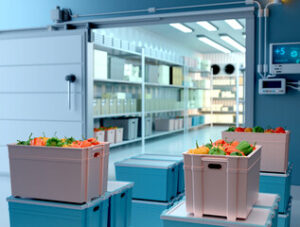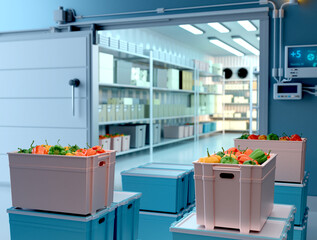Restaurant refrigeration keeps food at optimum temperatures for the best color, flavor, and nutrition. It is also energy efficient.
Keeping up with the maintenance tasks that your equipment requires is important. Some of these are best left to the professionals. This helps your refrigerators last longer. There are several different types of restaurant refrigeration equipment available, check out https://alltemprefrigerationfl.com/.
 Commercial Refrigerators
Commercial Refrigerators
Refrigerators are crucial to any restaurant because they help keep food items at the right temperature for optimum taste and freshness. They also prevent spoilage and contamination. Commercial refrigerators are made with more durable materials than residential fridges and can withstand heavy use in busy kitchens. They are also more energy-efficient and easier to maintain.
There are many different types of commercial refrigerators available on the market, so it is important to choose one that fits your business needs. The type of refrigeration you need depends on the size and type of your restaurant, the amount of storage space available in your kitchen, and your food delivery schedule.
Commercial fridges come in a variety of sizes and types, from small under-bench units to room-sized walk-in freezers. Some are designed for specific applications, such as sushi display cases and delis. Others are designed to showcase food products, such as desserts and sandwiches. Some are even made for outdoor use.
Some types of commercial refrigerators have multiple functions, including combination units. These units start as a reach-in and then convert to an awesome merchandiser or vice versa. They are ideal for restaurants that offer a mix of dining and take-out options.
A commercial refrigerator is a piece of equipment used to store food and drinks in the back of a restaurant or other establishment. These refrigerators are regulated to the proper temperature using a thermostat. They are usually made with stainless steel, making them durable and easy to clean. Some have a glass door, which allows customers to see the contents inside.
The main difference between a commercial and residential refrigerator is the power. Commercial refrigerators have a lot more cooling power than residential ones, so they can chill foods and beverages much faster. In addition, they can withstand harsh conditions, such as high humidity levels. They are also more expensive than residential refrigerators, but they are worth the investment for any business that needs to keep food cold. They can also be found in a range of colors and styles. These include stainless steel, white, and black.
Reach-in Refrigerators
Reach-in refrigerators are an essential piece of equipment for any restaurant, cafeteria, pizzeria, or other food-serving establishment. They help keep prepared foods and raw ingredients cold, and they can also be used to store frozen foods and beverages. Unlike walk-in refrigeration, which requires a dedicated freezer room, reach-in refrigerators can be placed in the kitchen or an open area that is easy to access. They come in single–, two-, or three-door models and are available in a variety of sizes to suit any establishment.
When choosing a reach-in fridge, consider its capacity and the amount of storage space you will need. If the fridge is too small, it will be inefficient and may lead to food spoilage. Similarly, if it is too large, it will be hard to organize and will waste energy. A good option is to estimate how much your restaurant will grow over the next several years and buy a fridge that will accommodate that demand.
Another important factor is the style of the doors. You should choose swinging doors if you have enough room for them, or sliding doors if you need to conserve space on limited kitchen floors. Half-door options are available as well, and they can save energy costs by reducing the cooling time for the interior of unopened refrigerators. It is also a good idea to check the hinges and gaskets regularly for looseness, which can cause air to enter the unit and affect its temperature. You should also take regular temperatures and keep a log of them.
In addition to the door style, you should decide whether to get a bottom-mounted compressor or a top-mounted model. The bottom-mounted models have the evaporator coils at the bottom of the fridge, which allows them to stay 15 degrees cooler than the surrounding environment. This makes them more efficient and easier to clean. You should avoid putting your reach-in fridge near a convection oven or griddle, as it will be subject to hot ambient temperatures that can cause the compressor to break down.
After deciding on the size and utility of your new refrigerator, you should measure the dimensions of the room where you will put it. This will ensure that it fits the space and can be easily moved if necessary. You should also ensure that the refrigerator is installed in a cool, dry place away from heat-generating appliances. Lastly, make sure that the refrigerator has a dedicated electrical circuit with the right voltage to avoid overheating and damaging it.
Walk-in Refrigerators
Walk-in refrigerators are the refrigeration solution for restaurants that have the space and need to store large amounts of food in a safe, refrigerated environment. They keep food at FDA-required temperatures and reduce waste by minimizing the amount of food that is thrown away. They can also help save time by reducing trips to the market and decreasing the risk of running out of key ingredients.
The first step in purchasing a walk-in is to determine your specific needs. For example, you should consider how much refrigeration space you need and if you will need a floor or ramp. You should also consider the size of the door and whether you will need a curtain or panel. Then you should decide whether you want to purchase a quick-ship walk-in box or a custom unit. Quick-ship walk-in boxes are fabricated to standardized dimensions and shipped pre-configured, while custom units are fabricated and compiled for your specific specifications and assembled by professionals on-site.
Walk-ins are made of many different materials, but they should be durable and easy to clean. They should also be insulated to protect the product inside and minimize energy usage. Extruded polystyrene is the best choice for insulation because it can withstand moisture and provides a good R-value. Another option is laminated panels, which are constructed of polyurethane slabs attached to the walls.
When choosing a walk-in, you should look for a model with high-efficiency motors to reduce operating costs. You should also choose a model that is EISA-compliant to ensure compliance with new regulations. EISA-compliant compressors have lower noise levels, higher efficiency ratings, and longer life than non-compliant models. They are also more environmentally friendly and are less sensitive to temperature fluctuations.
Undercounter Refrigerators
Undercounter refrigerators are a great addition to any restaurant or commercial kitchen and can be used for storing small food items like soups, sauces, and dips. They are also useful for storing beverages such as soda, water, juices, and cocktails. They are usually smaller than traditional reach-in refrigerators, so they can be placed under a counter or in a prep area where space is limited. They can be installed freestanding or built-in, and are available with both solid doors and drawers.
Many under-counter refrigerators have removable shelves to make it easy to store different foods and beverages. Some models have different zones set at different temperatures so that you can keep fruits, vegetables, and meats in separate sections. Some also have bins for large jugs or bottles of wine and beer. These fridges are also ideal for chilling cocktails and glassware before serving.
Some under-counter refrigerators are designed with a heavy-duty worktop that can be used as a prep table. These units are typically used in restaurants, bars, or catering services where space is limited. Some under-counter refrigerators also have a backsplash to protect walls and nearby equipment from food spills during preparation.
Most under-counter refrigerators are either freestanding or built-in and come with a stainless steel countertop. They are often designed to be concealed under a counter, so they can blend in with the decor of your restaurant. They are also available in a variety of sizes and styles, so you can find the perfect one to suit your needs.
When choosing an under-counter refrigerator, be sure to consider its location in your restaurant and pay attention to the clearance requirements. If the fridge is located too close to a heat source, it will have to work harder to maintain cool temperatures, which can shorten its life. You should also check the clearances between the fridge and its front grill, which is where it vents air. Keeping this area clean is important, as it can help prevent clogs and increase efficiency.
Many under-counter refrigerators are equipped with a digital temperature display that makes it easier to adjust the temperature. They may also have a touchpad control panel for simple operation. Some models are also field reversible and can be shipped with either the right- or left-hand door swing.



